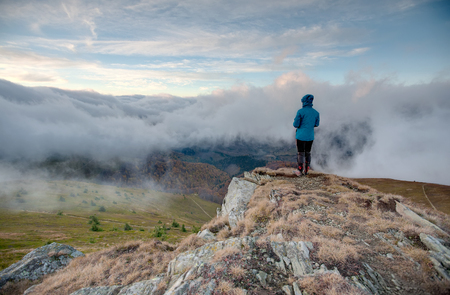Understanding the British Weather: Why Layering Matters
If you’ve spent any time outdoors in Britain, you’ll know that the weather rarely stays the same for long. The UK is infamous for its sudden downpours, brisk winds, and temperature swings—all of which can happen within the space of an afternoon, especially when you’re out on a climb or trek. This unpredictability means that a single jacket or base layer simply won’t cut it. Instead, effective layering is the key to staying comfortable and dry, no matter what the forecast says. On British hillsides and crags, microclimates often develop quickly—one moment you’re sheltered in a sunny valley, the next you’re battling a chill breeze on an exposed ridge. These shifts demand flexibility in your clothing choices. By mastering the art of layering with waterproofs and other technical kit, you can adapt to these ever-changing conditions without overheating or getting soaked through. In short, thoughtful layering isn’t just about comfort; it’s about safety and making sure your adventures remain enjoyable regardless of what the sky throws at you.
2. The Base Layer: Managing Moisture and Comfort
When tackling British climbs and treks, the unpredictability of the weather demands thoughtful base layer choices. Your base layer is the first line of defence against discomfort caused by sweat and dampness—a key consideration, whether you’re slogging up Ben Nevis or trekking through Dartmoor’s rolling mist. The primary function here is moisture management: transporting sweat away from your skin to keep you dry, regulate body temperature, and prevent that dreaded cold clamminess when the rain inevitably sets in.
Material Matters: Merino Wool vs Synthetics
Two materials dominate base layer discussions in Britain: merino wool and synthetics. Each has unique properties suited to different preferences and environments.
| Material | Pros | Cons |
|---|---|---|
| Merino Wool | – Excellent moisture-wicking – Odour-resistant – Warm even when wet – Soft on skin |
– Slower drying time – Pricier than synthetics – Can be less durable over time |
| Synthetics (e.g., polyester, polypropylene) | – Rapid drying – Durable and lightweight – Cost-effective – Good at moving sweat away from skin |
– Can retain odours – Less warmth when wet – Sometimes feels less comfortable directly on skin |
Sweat-Wicking Priorities for UK Conditions
The constant threat of rain or drizzle means your base layer should never hold onto moisture for long. For sweaty ascents or humid rambles, a synthetic top can move sweat away efficiently and dries quickly if you’re caught in a sudden downpour. However, for multi-day trips or colder conditions, merino’s warmth—even when wet—and its natural anti-odour qualities make it a favourite among seasoned hillwalkers.
Tips for Choosing Your Base Layer:
- Prioritise fit—close to skin but not restrictive, allowing for full movement.
- Consider activity length: synthetics for short, high-intensity outings; merino for longer adventures.
- Avoid cotton—it soaks up water, stays wet, and chills you rapidly.
Selecting the right base layer isn’t about chasing trends but understanding how your body responds to British weather. Invest in quality, match the fabric to your trek’s demands, and you’ll lay a solid foundation for comfort under any waterproof shell.

3. Mid Layers: Insulation Suitable for UK Conditions
Mid layers play a pivotal role in your layering system, especially when tackling the unpredictable weather that British climbs and treks are notorious for. The purpose of a mid layer is to trap body heat while remaining breathable, ensuring you stay warm without overheating as conditions fluctuate from misty drizzle to sharp gusts on exposed ridges.
When choosing an insulating mid layer for the UK, versatility is key. Fleece jackets remain a firm favourite among hillwalkers and climbers thanks to their lightweight warmth and ability to wick moisture away from your base layer. For more challenging or colder outings, consider synthetic insulated jackets. These offer reliable warmth even when damp—an essential trait given the UKs frequent showers and persistent humidity. While down insulation excels in dry, cold environments, it’s often less practical here unless protected by your waterproof shell at all times.
Breathability should never be overlooked. Look for garments featuring full-length zips, mesh panels, or venting options that allow you to regulate your temperature quickly during strenuous ascents or sudden clear spells. In addition, opt for materials that offer a good stretch; this flexibility ensures your range of movement isn’t restricted when scrambling over rocks or adjusting kit on blustery summits.
Finally, always consider packability. British weather can turn in an instant—a mid layer that compresses easily into your rucksack makes it simple to add or remove insulation as needed without fuss. Remember: successful layering is about adapting swiftly to the hills’ ever-changing moods.
4. Choosing the Right Waterproofs
When tackling the varied British weather on a climb or trek, your choice of waterproof jacket and trousers is every bit as important as your base layers. The UK’s famously unpredictable conditions—think sideways rain, gusty wind, and sudden temperature shifts—demand technical kit with features tailored for these challenges.
Key Features to Consider
| Feature | Why It Matters | UK-Specific Advice |
|---|---|---|
| Breathability | Prevents overheating and manages sweat during high-output activities. | Look for jackets rated with a high MVTR (Moisture Vapour Transmission Rate); underarm zips are a bonus on steep Lake District ascents. |
| Packability | Makes it easier to stash your shell when not in use; critical for changeable British weather. | Packs small into a rucksack side pocket—ideal for quick access on exposed ridges or coastal walks. |
| Cuff Design | Keeps water from running down your sleeves and improves glove compatibility. | Adjustable Velcro cuffs help seal out wind-driven rain common on Scottish Munros. |
| Hood Construction | A good hood protects against both rain and wind chill, keeping you warm and dry. | A wired peak stops rain dripping into your eyes; helmet-compatible hoods are ideal if you’re scrambling or winter climbing. |
| Trousers Fit & Access | Allows layering underneath and easy removal over boots. | Look for full-length side zips for quick changes mid-downpour, even when wearing walking boots. |
The Value of Good Zips and Seams
Waterproof zips and taped seams are often overlooked but crucial. British rain rarely falls straight down; driving winds can force water through weak points. Fully sealed seams and storm flaps make all the difference when caught in a Cumbrian squall or Dartmoor drizzle.
Local Insights: What Brits Swear By
Many seasoned UK hillwalkers prefer jackets with slightly longer backs for extra coverage when bending or scrambling. Pit zips, handwarmer pockets placed above harness level, and reinforced shoulders help cope with rucksack abrasion—details that matter in real-world British use. When in doubt, try kit on over all your intended layers and move about; comfort and mobility trump fashion here every time.
5. Practical Layering Tactics on British Climbs and Treks
Layering effectively on British hillsides is as much about adaptability as it is about preparation. The unpredictable nature of our weather—sudden showers, chilly winds, and bursts of sunshine—means your approach must be dynamic and practical. Here are some real-world strategies for keeping comfortable and dry while out on a walk or tackling a challenging climb.
Stay Attuned to the Weather
Before setting off, check the latest Met Office forecast and be ready to adapt mid-route. Always start with your base layer and have your mid-layer and waterproof handy at the top of your rucksack for swift access. If the sky darkens or you feel a nip in the air, don’t hesitate to stop briefly and add or remove a layer—prevention is better than cure when it comes to chill or sweat.
Master Quick Changes
Practice swapping layers efficiently so you’re not faffing about in the drizzle. Choose jackets with two-way zips and easy-grab tabs so you can pull them on without taking off your gloves. When the heavens open, whip out your waterproof before your kit gets soggy—pack it last so it’s first out. For trousers, side zips let you slip them over boots swiftly if you get caught in a squall.
Keep Essentials Dry and Accessible
Use dry bags inside your rucksack for spare socks, hats, or that all-important sandwich. Stash gloves, map, and snacks in easily accessible pockets so you don’t need to rummage around in the wet. A small waterproof pouch for your phone or GPS is a sound investment too—British rain has no mercy on electronics.
Adapting as You Go
If you’re climbing steadily uphill, unzip vents on jackets or take off your hat to avoid overheating. At summits or lunch stops, add an insulating layer before you cool down too much—it’s easier to stay warm than to warm up again. Be mindful of wind direction: pop up your hood before turning into the breeze.
Final Tip: Know Your Kit
The best layering system is only as good as your familiarity with it. Before heading out on a big walk or trek, do a couple of trial runs locally—practice changing layers quickly and get used to where everything lives in your pack. This way, when Britain’s fickle weather turns, you’ll be ready to respond with confidence and keep enjoying the great outdoors.
6. Aftercare and Longevity
Once you’ve invested in quality waterproofs and perfected your layering system, taking care of your kit is essential for ensuring it continues to perform—especially given the relentless drizzle, mud, and grit found on British climbs and treks. Regular aftercare will extend the life of both your waterproof outer layers and base layers, keeping you comfortable regardless of what the Lake District or Scottish Highlands throw at you.
Cleaning Your Waterproofs
Mud-spattered jackets are almost a badge of honour on UK trails, but letting dirt and grime build up can damage waterproof membranes over time. Always follow the care label instructions—generally, use a gentle cycle with a specialist cleaner (never standard detergent, as it can strip away water-repellent coatings). Rinse thoroughly to avoid residue, which can compromise breathability.
Reproofing for Performance
After a few outings, you may notice rain no longer beads up on your jacket’s surface. This signals it’s time to reproof using a spray-on or wash-in Durable Water Repellent (DWR) treatment. These products help restore the fabric’s ability to shed water rather than soak it up, critical for staying dry during protracted downpours common in the British hills.
Caring for Base Layers
Base layers work best when clean and free from odours. Wash them regularly using mild detergent at low temperatures; avoid fabric softeners as they can reduce wicking performance. Merino wool options especially benefit from air drying and occasional gentle stretching to maintain shape.
Storage Tips
Never store waterproofs or base layers while damp—this invites mildew and unpleasant smells. Hang garments up in a well-ventilated area and ensure they are completely dry before packing away. For long-term storage, avoid compressing waterproofs too tightly; instead, hang them or fold loosely to preserve fabric integrity.
A Commitment to Longevity
Proper aftercare isn’t just about hygiene—it’s an investment in your comfort and safety outdoors. With regular cleaning, timely reproofing, and careful storage, your layering system will be ready for whatever fickle British weather comes your way—be it sideways rain on Snowdon or thick mist on Kinder Scout.


